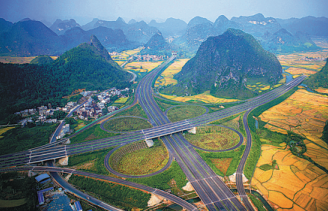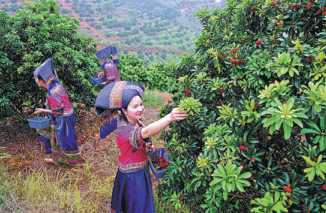Once unknown, Baise becomes industrial powerhouse


A network of expressways has helped connect Baise and the Guangxi Zhuang autonomous region with ASEAN countries and other parts of the country. CHINA DAILY
Guangxi border city and center of aluminum production poised to tap potential of RCEP
Editor's Note: China Daily is running a series of stories on old revolutionary bases with profound history and heritage that are striving to lead local people on the road to prosperity in the new era.
Decades ago, when Deng Xiaoping, chief architect of China's reform and opening-up policy, urged the exploration of aluminum in Baise city, in southern China's Guangxi Zhuang autonomous region, it was all but unknown.
Today, the city on the border with Vietnam is one of the most important national hubs for aluminum and produces about 2.4 million metric tons of electrolytic aluminum per year, about 5.6 percent of the national total.
Earlier this year, the temporary lockdown of production due to the COVID-19 epidemic in the region sent global aluminum prices rocketing to a 14-year high.
Behind this huge transformation are the city's efforts to strengthen the development of key industries, especially aluminum, a crucial component used in construction, automobile production and many other consumer goods.
It also reflects a broader blueprint for expanding high-level opening-up under the Regional Comprehensive Economic Partnership, one of the world's largest free trade agreements.
"The city will make full use of its unique location on the border with ASEAN economies and connections to many southwestern cities," said Huang Rusheng, Baise Party secretary.
"More efforts will be made to drive institutional innovation, infrastructure interconnection and industrial cooperation to help the city build an open, high-quality economic system."
Closer ties between China and ASEAN states under RCEP will mean further reductions to trade costs and the expansion of trade items.
With RCEP promoting tariff reductions, Baise is endeavoring to promote trade with other RCEP member countries and has vowed to increase participation by residents living near the border.
For instance, the city has launched specialized policies to make trade procedures, especially customs declaration and registration, more convenient.
"We are working to set up border trade cooperative stations and aid groups in every village within 20 kilometers of the border. The aim is to help residents take advantage of new trade policies," said Lan Tianning, head of the city's commerce bureau.

Urban residents pick fruit in an orchard in Baise city as part of a rural tourism program. ZHOU FUNING/FOR CHINA DAILY
To better reap the opportunities created by RCEP, Baise has also arranged for a group of key foreign trade enterprises, including the Pingguo Jianfeng Aluminum and Guangxi Shenbai Supply Chain, to learn about RCEP rules and regulations.
This kind of training helps companies develop a better understanding of the impact of RCEP on industries such as agriculture, textiles, machinery, chemicals and electronic information, and to understand the rules and application procedures of the agreement.
"With RCEP, Baise will become an important area for international freight trade, which is of great significance in facilitating trade between China and ASEAN countries," said Li Zhiming, secretary of the China International Logistics and Freight Forwarding Network.
Official data showed that imports and exports in Guangxi topped 593.06 billion yuan ($93.41 billion) last year, up 21.8 percent year-on-year.
Baise registered an economic growth rate higher than the national average, with GDP exceeding 100 billion yuan.
In 2020, the State Council, China's Cabinet, gave approval for the city to become a new development and opening-up pilot zone and said that it will be transformed into an important platform for China and ASEAN countries to cooperate on the Belt and Road Initiative.
Last year, despite the negative impact of the pandemic, total foreign trade volume in the pilot zone reached 42.63 billion yuan, a year-on-year increase of 28 percent.
In addition to industrial development, the city has also gained momentum in sectors like agriculture. Baise is home to one of the country's largest mango cultivation areas.
The Baise Mango was added to a list of protected geographical indications recognized by China and the European Union, opening the door for it to enter the overseas market.
MOST POPULAR
- 1 $39.7 billion worth of deals inked at Airshow China
- 2 China announces tax relief measures to stabilize real estate sector
- 3 A look at China's economy in October, 2024
- 4 Public holiday extension announced
- 5 China's NEV annual production hits 10 million milestone amid global carbon reduction efforts
Editors' Picks
 Infographic:
Golden jubilee of China-Brazil relations
Infographic:
Golden jubilee of China-Brazil relations
 Infographic:
A look at China's economy in October 2024
Infographic:
A look at China's economy in October 2024





